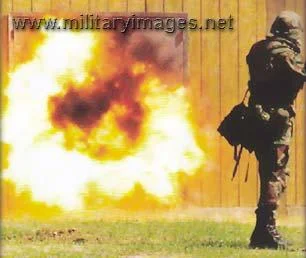Soldiers will be able to blast a door in from nearly half a football field away using a new munition fielded by Program Manager Soldiers and the Directorate of Combat Development's Small Arms Division.
The Grenade Rifle Entry Munition M-100 system was designed minimize the time Soldiers are in the "fatal funnel," the line of fire in front of a door where Soldiers can be wounded while trying to enter a building.
"The problem is, when Soldiers try to enter a building, they don't know what's on the other side of the door," said John Amick, senior systems analyst with DCD's Small Arms Division. "It could be a guy with a machine gun pointing straight at them. The GREM moves Soldiers away from the door and gets them out of the fatal funnel."
Without the GREM, Soldiers can knock down a door with a battering ram, explosives or by shooting the lock with a shotgun. Those methods all put troops close to a building and in harm's way, Amick said.
With the GREM, a Soldier can stand as close as 15 meters or as far as 40 and fire at a door straight on, or at a 20 degree angle from the right or left.
To use the GREM, a Soldier slides the tail section onto the muzzle of an M-16 or an M-4, and launches the GREM by firing the weapon.
"The GREM does not attach to the weapon used to fire it, so a Soldier is ready to shoot again immediately after firing the GREM," said Staff Sgt. Robert Jones, the Small Arms Division Crew Served Project NCO. "It is also fired using regular M-16 or M-4 rounds, so a shooter doesn't have to worry about using special ammunition."
Previous breaching technology could blast holes through doors, but the GREM is designed to blast the door out of its frame, making the door fall in. Its design uses a footlong "standoff rod," which hits the door first. The impact sets off a disk-shaped explosive round inside the GREM. The charge's rounded shape causes the force of the explosion to be dispersed across the door's surface, rather than through the door, Amick said. Spreading out the force causes the door to fall rather than break, so Soldiers can easily enter a room.
If there are noncombatants inside a room, they will not be injured by flying pieces of the door, Jones said.
The GREM will not significantly add to an Infantryman's load, Jones said. It weighs only 1.37 pounds, and consists of two pieces about 15 inches long that are screwed together before being fired. The designers made the GREM as light and easy to carry as possible since Infantrymen have so much other gear, he said.
Jones spent most of March and April in Iraq training 64 Soldiers from the 101st Airborne Division's 3rd Brigade Combat Team to use the GREM. All of the 3rd BCT officers and NCOs became certified as trainers to teach other units to use the GREM.
At this time, only the 3rd BCT has the authority to use the GREM, but it should be fielded to other units as early as October, Jones said.
The Army's plan is to issue two types of GREMs: one for training and one live munition for use in combat. The training munitions can be used repeatedly so Soldiers can become familiar and comfortable with the weapon before using the live munition.
The Small Arms Division received requests from six other units trying to get the GREM, and Amick said Soldiers shouldn't have to wait long.
"If they haven't seen one yet, they will soon," he said.
[url=
http://www.liveleak.com/view?i=a01885f6e9&p=1]GREM Video[/url]










